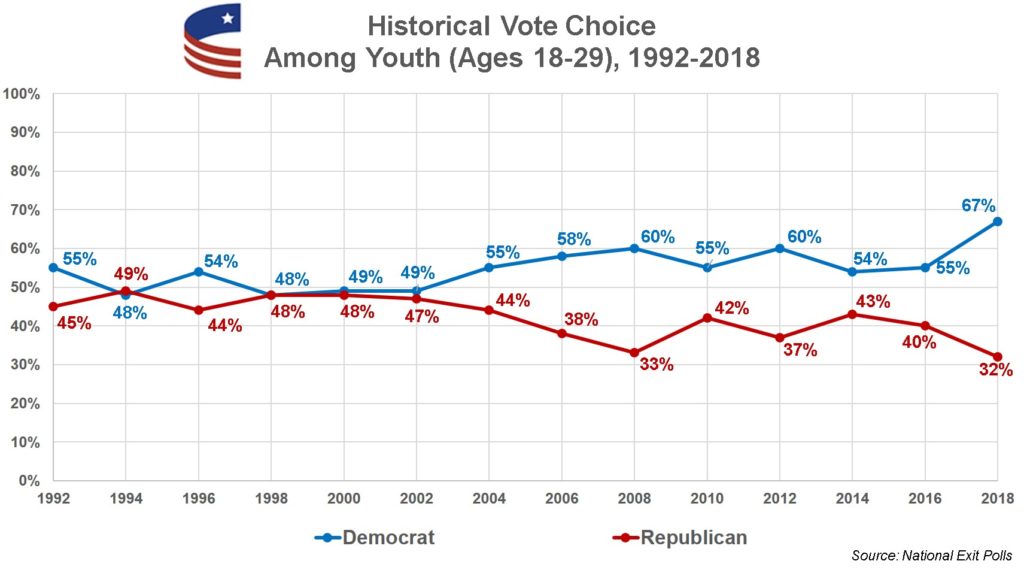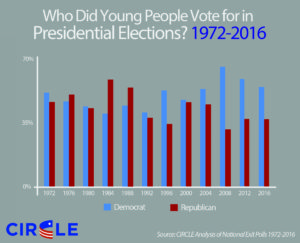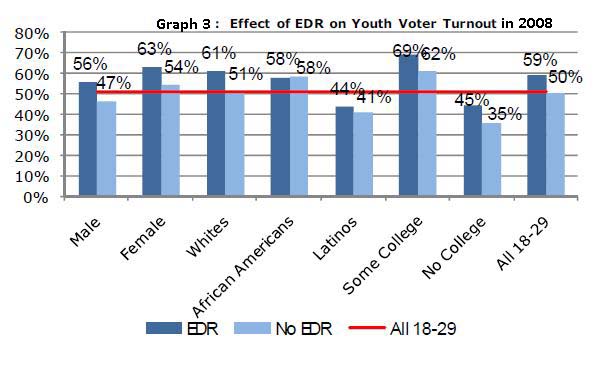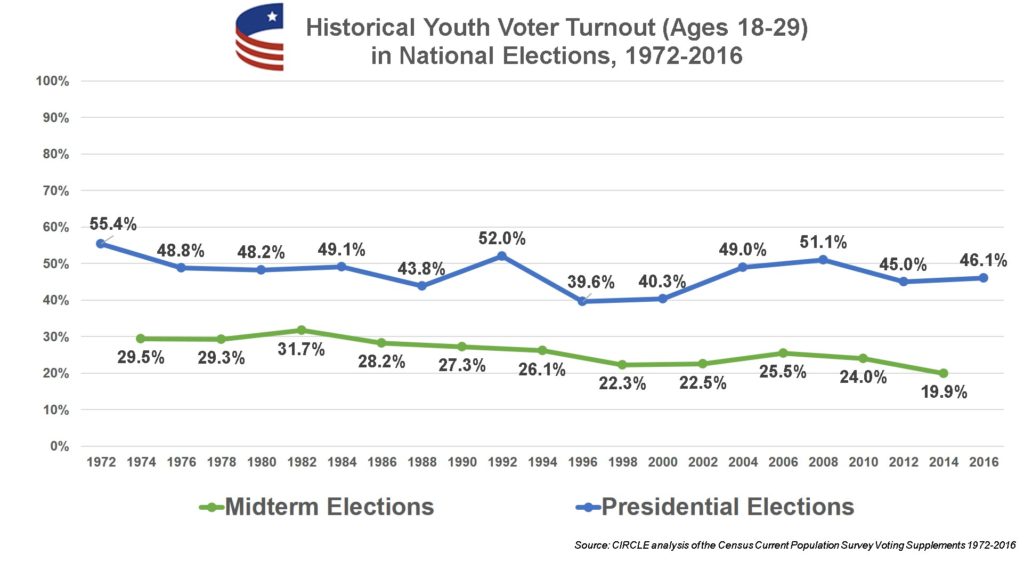Youth Voting
Youth Voting Historically | The Youth Vote in 2018 | The Youth Vote in 2016 | Why Youth Voting Matters | What Affects Youth Voting | What Works in Getting Youth to Vote | Resources
- We estimate that 31% of eligible young people voted in the 2018 midterm elections, a dramatic increase over the youth turnout in 2014 and the highest level of youth participating in a midterm cycle in at least the last 25 years.
- Young people favored Democratic House candidates in the 2018 midterms by an overwhelming and historic margin of 35 percentage points: 67% for Democrats, vs. 32% for Republicans.
 |
 |
Explore our 2018 Election Center for all of our 2018 data and analysis
- According to our initial, post-election estimate, approximately 50% of eligible young people—about 24 million youth, ages 18-29—voted in the 2016 general election. That’s a similar turnout rate to the one we calculated in 2012.
- 55% of young people voted for Hillary Clinton, while 37% supported Donald Trump. The remaining 8% of youth voted for a third-party candidate or did not cast a ballot for president. There were significant differences in youth vote choice by race, gender, educational attainment, and other factors.
- The youth electorate was as diverse as the general youth population, and as the youth electorate in recent elections: 61% White, 15% African-American, 17% Latino, 5% Asian-American, and 3% other.
Read our Full Analysis of Young Voters in the 2016 General Election
 |
 |
 |
- Voting is habit-forming: when young people learn the voting process and vote they are more likely to do so when they are older. If individuals have been motivated to get to the polls once, they are more likely to return. So, getting young people to vote early could be key to raising a new generation of voters.
- Young people are a major subset of the electorate and their voices matter:
- 46 million young people, ages 18-29, are eligible to vote, while 39 million seniors are eligible to vote
- Young people (ages 18-29) make up 21% of the voting eligible population in the U.S.
- Young people’s participation can influence election results.
- Involving young people in election-related learning, activities and discussion can have an impact on the young person’s household, increasing the likelihood that others in the household will vote. In immigrant communities, young voters may be easier to reach, are more likely to speak English (cutting down translation costs), and may be the most effective messengers within their communities.
And there are major differences in voter turnout among youth subgroups, which may persist as these youth get older if the gaps are not reduced.
- Contact! Young people who are contacted by an organization or a campaign are more likely to vote. Additionally, those who discuss an election are more likely to vote in it.
- Young people who are registered to vote turn out in high numbers, very close to the rate of older voters. In the 2008 election, 84% of those youth 18-29 who were registered to vote actually cast a ballot. Youth voter registration rates are much lower than older age groups’ rates, and as a result, guiding youth through the registration process is one potential step to closing the age-related voting gap.
- Having information about how, when and where to vote can help young people be and feel prepared to vote as well as reduce any level of intimidation they may feel.
- A state’s laws related to voter registration and voting can have an impact on youth voter turnout. Seven out of the top 10 youth turnout states had some of the more ambitious measures, including Election Day registration, voting by mail (Oregon), or not requiring registration to vote (North Dakota).
In 2008, on average, 59% of young Americans whose home state offered Election Day Registration voted; nine percentage points higher than those who did not live in EDR states. For more on state voting laws see: “Easier Voting Methods Boost Youth Turnout“; How Postregistration Laws Affect the Turnout of Registrants; State Voting Laws and State Election Law Reform and Youth Voter Turnout .

- Civic education opportunities in school have been shown to increase the likelihood that a young person will vote. These opportunities range from social studies classes to simulations of democratic processes and discussion of current issues. Unfortunately, many youth do not have these civic education opportunities, as research has shown that those in more white and/or more affluent schools are more likely to have these opportunities.
- A young person’s home environment can have a large impact on their engagement. Youth who live in a place where members of their household are engaged and vote are more likely to do so themselves.
What Works in Getting Youth to Vote
- Registration is sometimes a larger hurdle than the act of voting itself. Thus showing young people where to get reliable information on registration is helpful.
- Personalized and interactive contact counts. The most effective way of getting a new voter is the in-person door-knock by a peer; the least effective is an automated phone call.
- The medium is more important than the message. Partisan and nonpartisan, negative and positive messages seem to work about the same. The important factor is the degree to which the contact is personalized.
- Canvassing costs $11 to $14 per new vote, followed closely by phone banks at $10 to $25 per new vote. Robocalls mobilize so few voters that they cost $275 per new vote. (These costs are figured per vote that would not be cast without the mobilizing effort).
- The medium is more important than the message. Partisan and nonpartisan, negative and positive messages seem to work about the same. The important factor is the degree to which the contact is personalized.
- Begin with the basics: information. Telling a new voter where to vote, when to vote and how to use the voting machines increases turnout.
- Talk to them! Leaving young voters off contact lists is a costly mistake. Some campaigns still bypass young voters, but research shows they respond cost-effectively when contacted.
- For more information: Young Voter Mobilization Tactics; The Effects of an Election Day Voter Mobilization Campaign Targeting Young Voters by Donald P. Green.
A voter turnout time series for 1972-2012 (Excel spreadsheet)
Fact Sheets:
2013
2012
- Support for President Obama Varied Greatly by Gender and Race
- Young Voters in the 2012 Presidential Election: The Educational Gap Remains
- Young Voters in the 2012 Presidential Election
2011
2010
- Young Voters in the 2010 Elections
- Voter Registration Among Young People in 2008
- Will Young Voters Turn Out for the 2010 Election?
- The Minority Youth Vote in the 2008 Presidential Election
- Voter Turnout Among Young Women and Men in the 2008 Presidential Election
- The “Forgotten Half”: Education Disparities in Youth Voter Turnout
- Young people of faith more likely to be engaged than non-religious counterparts
2009
2008
2007
- Quick Facts About Young Voters by Metropolitan Area: The Midterm Election Year 2006
- Young Urban Voters in the Midterm Election Year 2006
- Youth Voter Turnout Increases in 2006
- Quick Facts About Young Voters by State: The Midterm Election Year 2006
2006
2005
- The Youth Vote in 2004
- Youth Voter Turnout in the States during the 2004 Presidential and 2002 Midterm Elections
- Electoral Engagement Among Minority Youth
- Voter Turnout Among Women and Men
- Electoral Engagement Among Non-College Attending Youth
2004
- College students in the 2004 Election
- State Voter Registration and Election Day Laws
- Young People and Political Campaigning on the Internet
2003
Research Report:
Working Papers:
2010
2009
- Predicting Civic Engagement in Urban High School Students
- Local and Absentee Voter Registration Drives on a College Campus
- Making Educational Progress: Links to Civic Engagement During the Transition to Adulthood
2004
- How Post-registration Laws Affect the Turnout of Registrants
- Throwing a Better Party: Local Mobilizing Institutions and the Youth Vote
2003
For more information on youth voting:





